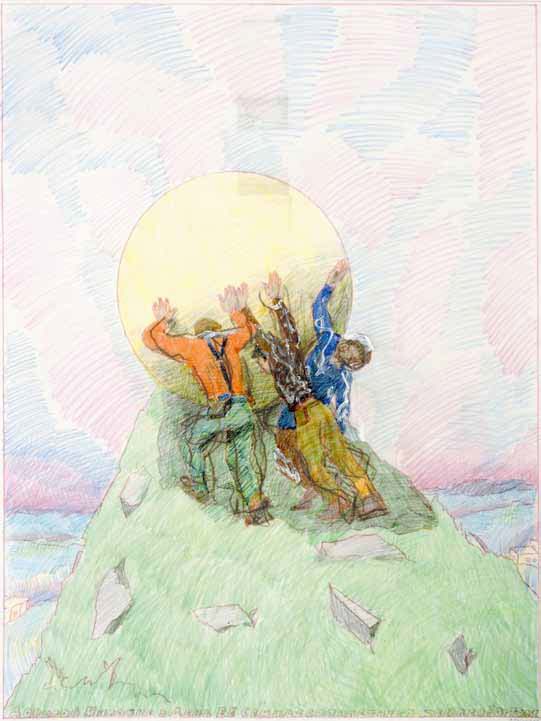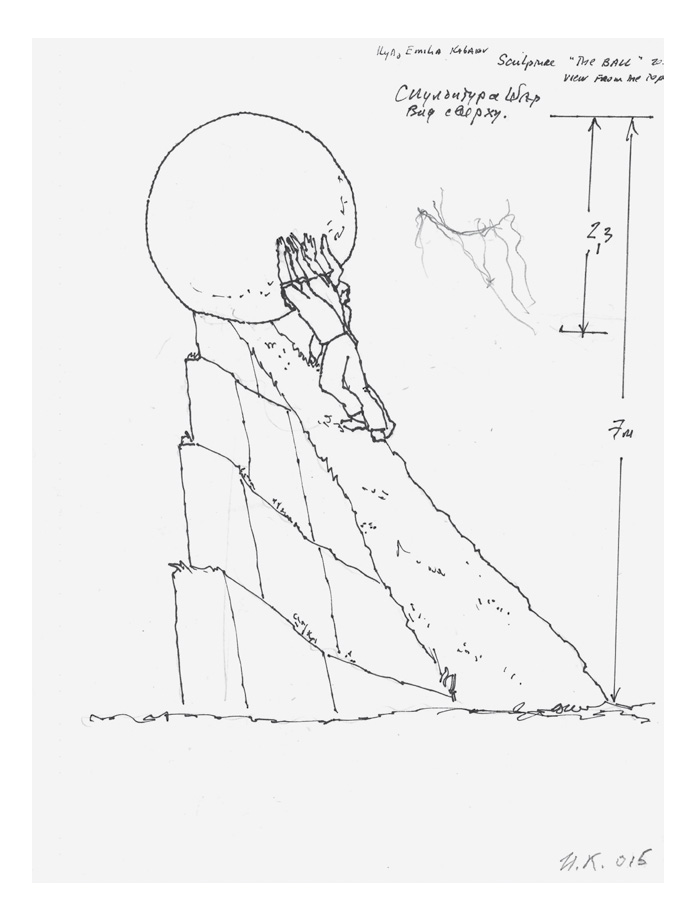The Ball
with Emilia Kabakov
YEAR: 2017
CATALOGUE NUMBER: 198
PROVENANCE
Collection of the Kistefos-Museet (Kistefos-Museum), donation by Christen Sveaas
EXHIBITIONS
Sculpture Park of the Kistefos-Museet, Jevnaker, Norway
Permanent installation, since May 21, 2017
DESCRIPTION
1- Construction of the mountain
A. The mountain
The mountain consists of three parts: the inner, main part will be made of a mixture of stones and cement. It has to look monolithic and be extremely stable, to be able to withstand any kind of climatic changes.
B. The front, vertical part of the mountain has to be made from local, gray stone and “fortified” to the main, stone/cement part in the form of wide steps, the same way it is shown in the sketches. It has to project the image of the typical vertical cut of the “natural mountain,” the same as in the real hills/mountains of Norway.
C. The other side, the slope of this “mountain,” will be covered by grass. The thin cover of earth is placed on this side and the grass is planted there. It has to be done in such a way that the earth there wouldn’t be washed away by rainwater. The height of the mountain is shown on the sketch.
2- The ball
The ball has to be made of fiberglass or a composite/mixture of marble dust and plastic in the color of marble, the same as the three figures supporting the ball. It has to be secured inside the mountain; for details and size, look at the sketch #1/1.
3- The figures
All three figures of the men have to be made of fiberglass or composite materials, the same “marble” color as the ball. Each figure is secured to the mountain and to the ball. The sizes of the figures are also in the sketch.
CONCEPT OF THE INSTALLATION
The beautiful landscape where Kistefos is located calls for monumental work. At the same time, the artist has to be very careful not to overwhelm the beauty of the surrounding nature. To make sure that the artwork looks like it is supposed to be there or is there for a very important reason.
The human being has always been trying, on the one hand, to conquer the nature, to dominate it, and, on the other, to coexist in some kind of mutual understanding and harmony.
The history of humanity is full of legends, fairy tales, and sagas about trying to reach the top of the hill, the top of the mountain, the top of the world.
This sculpture is an image of the attempt to do exactly this: to get to the top, to bring this ball to the very top of the world. And it’s a celebration of human unbreakable soul, determination, and, finally, victory. The sculpture: Consists of three figures and a ball, made of either fiberglass or strong composite which can withstand the weather.
Materials:
The hill has to be made of stone, covered with earth, and planted with grass. The view of the horizon as the background for the sculpture is very important.
Dimensions:
The hill: 7 m high and 5.5 m long
The ball: 2.3 m
The figures: first: 1.8 m; second: 2 m; third: 1.9 m
The production can be made locally under the supervision of the artists.
Images
Literature









